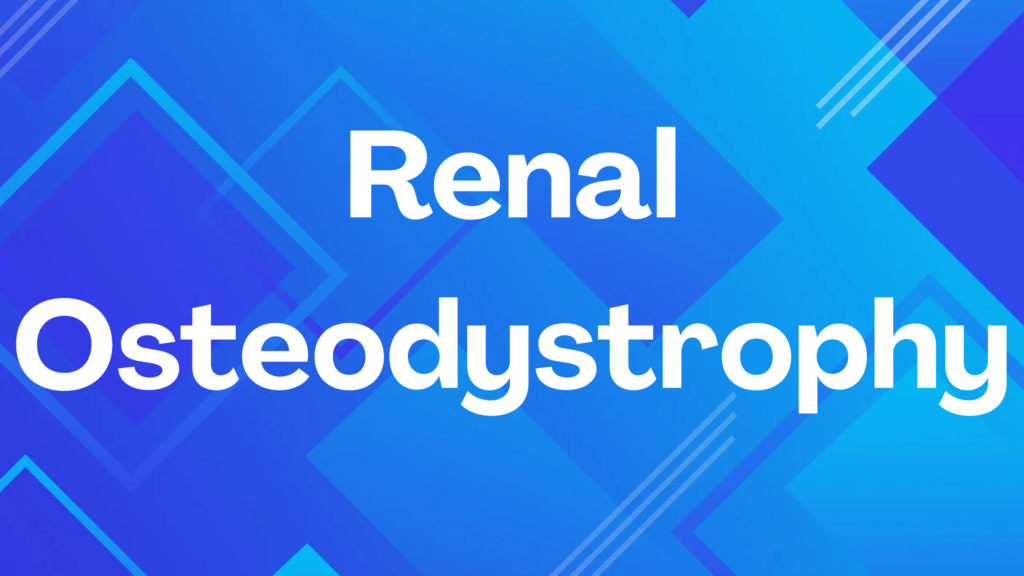Renal Osteodystrophy is a bone disease that occurs as a result of chronic kidney disease (CKD), where the kidneys are no longer able to effectively filter waste and balance important minerals like calcium, phosphorus, and vitamin D. This imbalance affects the bone health, causing weakening, pain, and deformities. It’s a complication of kidney failure and is often seen in patients with end-stage kidney disease or those on dialysis.
Here’s a breakdown of Renal Osteodystrophy with emojis:
🧠 Kidney Problems:
- Renal Osteodystrophy develops as a consequence of chronic kidney disease (CKD) or kidney failure, where the kidneys are unable to process minerals like calcium and phosphorus: 🩺💔
💀 Bone Weakening:
- Imbalance in calcium and phosphorus leads to weak bones that are more prone to fractures, pain, and deformities: 💔🦴
- Calcium: Low calcium levels can make bones more fragile: 🦴💔
- Phosphorus: High phosphorus levels can result in calcification of soft tissues and bone pain: ⚖️💥
🔻 Vitamin D Deficiency:
- The kidneys also play a key role in converting vitamin D into its active form, which helps absorb calcium. In kidney disease, this process is impaired, leading to vitamin D deficiency: 🧑⚕️💧❌
⚖️ Imbalanced Mineral Levels:
- Elevated phosphorus and low calcium levels, combined with poor vitamin D conversion, contribute to bone damage and osteodystrophy: ⚖️🔄💀
🦴 Symptoms:
- Bone pain: The weakened bones become painful, especially in the spine, hips, and joints: 🤕🦵
- Bone fractures: The bones are more likely to fracture with minor injuries: 💥🦴
- Bone deformities: Deformities such as bowed legs, spinal curvature, or joint abnormalities: 🦵➡️
- Joint pain and stiffness: Joints become stiff and swollen: 🤕💥🦵
🧬 Causes:
- Renal osteodystrophy is caused by the impaired kidney function in chronic kidney disease and end-stage renal disease (ESRD), which leads to:
- Poor calcium absorption: 🦴🔴
- Increased phosphorus levels: ⚠️💣
- Vitamin D deficiency: 💧❌
🩺 Diagnosis:
- Blood tests to measure calcium, phosphorus, and parathyroid hormone (PTH) levels, which play a key role in regulating calcium and phosphorus: 💉🧬
- Bone density tests or X-rays to check for bone loss or deformities: 📸🦴
- Kidney function tests: To assess the severity of kidney disease: 🩺🧬
💊 Treatment:
Treatment focuses on balancing the minerals and maintaining bone health:
- Phosphate binders: Medications that help reduce the levels of phosphorus in the blood: 💊🔽
- Calcium supplements: To boost calcium levels in the body: 💊🦴
- Active Vitamin D: Supplementing with active vitamin D (such as calcitriol) to help with calcium absorption: 💊☀️
- Parathyroid hormone (PTH) management: Medications to control excess PTH production, which can be triggered by kidney failure and cause bone resorption: 💉🔬
- Dialysis: In advanced kidney disease, dialysis can help control mineral imbalances by removing excess phosphorus from the blood: 💧🩺
- Bone health monitoring: Regular checks on bone density and fractures: 🦴📉
🏥 Management:
- Regular monitoring of kidney function, mineral levels (calcium, phosphorus), and bone health: 🧑⚕️📊
- Diet: A low-phosphorus diet and calcium-rich foods can help manage the imbalance: 🍴⚖️
- Physical therapy: To improve bone strength and joint flexibility, and reduce fractures: 🧑🦱🏋️♀️
🚶♂️ Prevention:
While renal osteodystrophy is a complication of kidney disease, its progression can be slowed by:
- Early diagnosis and treatment of kidney disease: 🩺💡
- Careful management of calcium and phosphorus levels in the blood: ⚖️💊
- Adequate vitamin D levels: ☀️💊
